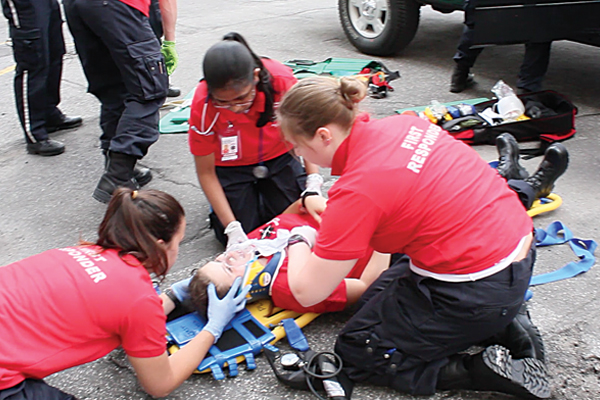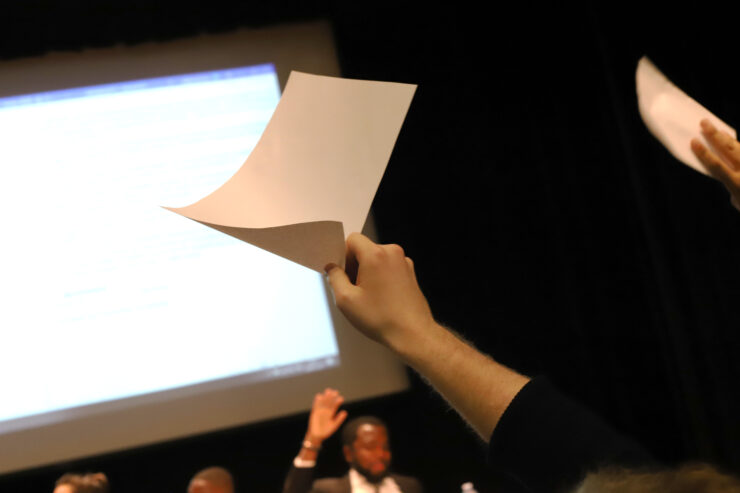No, not Noah’s—U of O to build Advanced Research Complex
Illustration courtesy of the University of Ottawa
On Sept. 26, the University of Ottawa broke ground on a five-storey building that will house the new laboratories of three of its most prominent researchers. Called the Advanced Research Complex (ARC), the building will be located on the east side of King Edward Avenue, across from the Minto Sports Complex. The ARC, scheduled to be completed in the summer of 2014 at the earliest, will provide multi-million-dollar laboratory space to the university’s vibrant photonics community.
According to Mona Nemer, vice-president of research at the U of O, the new building will make the university a leader in the field of photonics.
“ARC says something about where the university currently is and where it is going,” said Nemer.
The philosophy behind ARC is to bring researchers working in the fields of photonics and geosciences together into one space, regardless of their department or faculty. According to Thomas Brabec, chair of the department of physics, the complex will bring several faculties together.
“The final plan would be to move engineering and physics photonics together,” said Brabec. “The drawback is that the physics department is going to be split in half … but it might not be so bad.”
Paul Corkum, one of the three lead scientists responsible for ARC, agrees that organizing scientists by research interest rather than the traditional department won’t be an obstacle.
“As you build the photonics, you really want to bring people together,” said Corkum. “You want the engineers to know the scientists and the students to talk to each other. That’s how science works. So right from early on we wanted to bring people together.”
Corkum, who currently studies ultra-fast laser pulses in his laboratory at the Steacie Institute for Molecular Sciences at the National Research Council of Canada on Sussex Drive, will move to the ground floor of ARC in order to join fellow physicist Robert Boyd and geologist Ian Clark in the state-of-the-art facilities on campus.
Boyd, a world-renowned physicist who studies quantum nonlinear optics, joined the department of physics as the Canadian Excellence Research Chair (CERC) in 2010. The CERC position comes with $10 million in research funds, which Boyd will use to study how the velocity of light pulses travelling through material systems can be modified and controlled.
While Boyd recently moved to the U of O, Clark has been in the department of earth sciences for 30 years. His new laboratory in ARC will house a novel accelerator mass spectrometer that will rocket ions to nearly 10 per cent of the speed of light with very little sample contamination. This will allow Clark to detect the presence of trace radioisotopes at much lower concentrations than traditional mass spectrometers do.
“[The] instrument is actually built and ready to be delivered,” said Clark. “So it will be put into storage temporarily in Holland where it was built.”
Although the ARC building won’t be completed until 2014, Clark’s mass spectrometer will be installed early, in the fall of 2013.
“I tell you without a hint of exaggeration or hubris, our group is the best in the world for developing these new sources and technologies,” Clark said. “It is essential—and the university has been behind us on this—that we stay on top of our game.”
In many ways, Boyd, Clark, and Corkum will form the core of the research endeavors at ARC and are responsible for its creation.
In 2009, Corkum and Clark independently applied for large research grants, and the university submitted both applications to the Canadian Foundation for Innovation (CFI). Both applications were successful; CFI’s public records report infrastructure contributions of $4.7 million to Corkum’s project and $8.4 million to Clark’s.
“It wasn’t a joint project; there were independent applications,” explained Clark. “The two of them together were sufficient research mass to justify a new research building and that’s what [the university administration] was looking for.” The university pooled the funds to construct a single complex rather than two separate buildings or renovation projects for photonics and geology.
Corkum and Clark’s two CFI grants alone pay for 40 per cent of the construction costs of ARC. The Ontario government, recognizing the opportunity to have a world-class research facility in the province, agreed to match the CFI moneys, bringing the total to $25 million. Boyd contributed a further $1.5 million, and the university administration is covering the remainder of the construction costs (although according to the administration it has currently requested a further $2–3 million from CFI). A host of private partners have contributed to the scientific equipment that will populate the research centre.
Because of the sensitive nature of the optical and electron microscopy experiments to be performed in ARC, significant care was taken to design a building that would be stabilized against even the smallest vibrations from the outside world. In standard structures, wind, passing trucks, or even students running to class can cause tiny vibrations to reverberate through the building and misalign laser experiments.
“The ground floor is mechanically extremely stable,” said Corkum. “There was a big effort to maintain the stability of the laboratory. The basement floor will be isolated from the building, so if the building shakes, it’s okay; the floor doesn’t shake. And it will be locked to a seismic plate and subsequently tethered to the base of the rock.”
Corkum’s laser system will be attempting to image flash frozen cells 50 nanometers (nm) at a time using highly focused laser beams to desorb molecules and reveal what each 50-nm area is composed of, which is the primary reason why ARC is located on the east side of King Edward Avenue.
“All signs pointed to the other side of King Edward,” said Clark. “It hit on all criteria: vibration, the space needed, and it was a ‘green field’—there were no encumbering things on site.”
One thing the U of O cannot afford to do is waste space; however, the core researchers need only two floors. Photonics researchers will be on the third floor and the fourth floor will be space for geoscientists. The three lowest floors of the complex will be completed by 2014, but the top two floors will be “shelved,” left empty as an investment in space for the university in the future.





